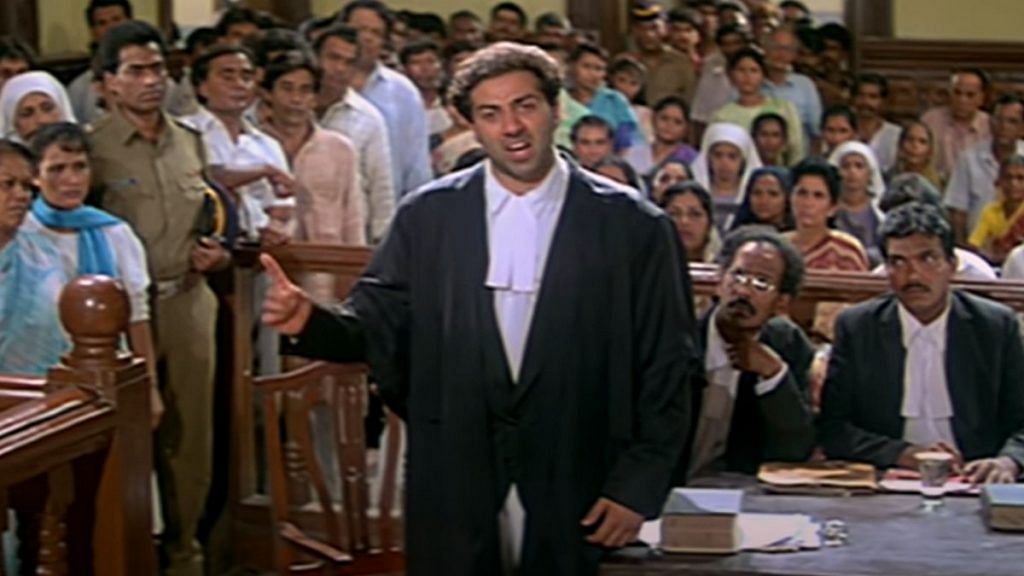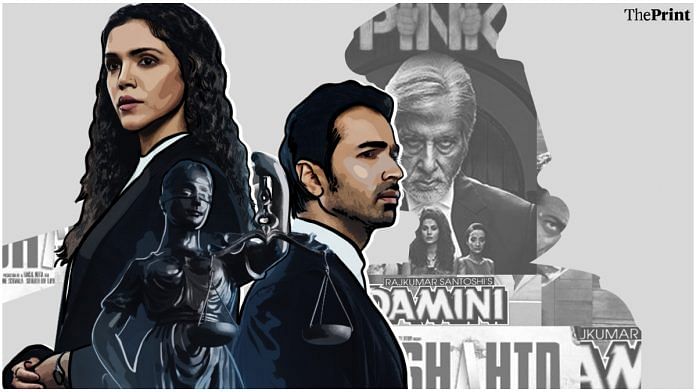Order, order, order! Few Indian imaginings of the courtroom don’t have a judge thundering this to lawyers going ballistic or spectators bursting into an uproar. Emotional “mein Gita pe haath rakh ke kasam khaata hoon” testimonies and witnesses having wild meltdowns on the dock are also classic tropes.
However, Amazon Prime’s Guilty Minds is the latest proof that the Hindi legal drama genre, such as it is, has evolved beyond the usual good vs evil narratives and nuance-less social messages.
Now, judges generally leave their gavels alone, the lawyers appeal to reason rather than emotion, and heroes and villains are kept out of the equation.
The first season, released last month, has 10 episodes, each dealing with a separate case, ranging from sexual assault and murder to copyright infringement, but also exploring the lives and dilemmas of lawyers, both inside and outside the courtroom.
So far, critics and lawyers have agreed that the show — written and directed by Shefali Bhushan and Jayant Digambar Somalkar — has done a good job capturing how the Indian legal system works, or at least for a section of urbane metro-based lawyers. In fact, actor Varun Mitra, who plays the cocky yet vulnerable lawyer Deepak Rana, told ThePrint, “After the first screening, many lawyers were ready to give us jobs!”
Until Guilty Minds, and before that the short-lived Vikrant Massey-starrer Criminal Justice, most aficionados of episodic legal dramas in India have had only US shows like Suits and Boston Legal to turn to. However, the country has seen some competent ‘legal’ films of late, like the multilingual Court (2014) and the Tamil Jai Bhim (2021).
Bollywood, too, has tempered its courtroom dramas in recent years, although many still have some of the same fatal flaws in their depiction of the legal system that they did in the ’80s and the ’90s.
Also Read: KGF, Pushpa, Baahubali — For South India, this is the era of multi-part movies
From Damini to Shahid and Pink
Some of the most iconic courtroom scenes in Indian cinema come from the 1993 film Damini.
The impassioned ‘tareekh pe tareekh’ diatribe delivered by Sunny Deol, who played an alcoholic but idealistic lawyer, in particular, resonated with many for its indictment of the infamous delays in the Indian judicial process. The film explored some other ‘progressive’ themes as well, depicting the principled fight of a homemaker (played by Meenakshi Seshadri) against her own in-laws to get justice for a domestic worker who was raped.
However, despite its feminist underpinnings and capturing of the adage ‘justice delayed is justice denied’, Damini’s courtroom scenes were a theatre for a classic good vs evil drama and did not attempt to portray the workings of the law realistically.

More recently, another critically acclaimed film in the genre was the 2013 Rajkumar Rao-starrer Shahid, a biopic on the late Shahid Azmi, a lawyer and human rights activist who set up a legal practice to help those wrongly accused of terror acts in India. The film succeeded in recreating some ‘realistic’ court scenes, but here too, the narrative firmly established who viewers needed to be rooting for.
Pink (2016), which featured Amitabh Bachchan as an aging lawyer, effectively highlighted rape culture and had some powerful court scenes, but as critics have pointed out, the ‘legal’ arguments depicted hinged excessively on emotion and “persuasion”, which, in real-world scenarios, are unlikely to change outcomes.
Nevertheless, with each subsequent film, there has been a definite growth and exploration of matters that each new decade throws up, or issues that have never quite been solved. What, however, remains consistent across cinematic depictions, in a manner, is the neat resolution of the matter, which is a rarity in the actual legal system in India.
The ‘lawyerverse’ of Guilty Minds
What sets apart Guilty Minds is, of course, its format, but also that the lawyers in the show are not heroes or villains — they are humans and professionals, who must follow the ethics of legal practice rather than principles of absolute morality.
The creators of the show first intended to name it ‘Mens Rea’, a Latin legal term that means criminal intent or evil mind. However, according to writer and director Shefali Bhushan, this term was too narrow for a show that aimed to explore guilt not just in the sense of criminal culpability but also in the minds of the lawyers fighting the cases.
“The idea was to look at the guilt in human minds, and not just legally,” she said.
In the ‘lawyerverse’ of Guilty Minds are the members of two law practices that run on very different ‘ethical’ lines.
One is a prestigious family-run law firm, Khanna & Khanna, and their star lawyer— an ‘outsider’ called Deepak Rana (played by Varun Mitra) who concerns himself with legalities more than personal ideas about morality.
In contrast is a lawyers’ collective, For The People, run by Kashaf Quazae (Shriya Pilgaonkar) and her partner Vandana Kathpalia (Sugandha Garg). The women usually take up pro bono cases (sometimes receiving payment in just jaggery!) or represent complainants who claim to have been ‘wronged’, such as in a case of sexual exploitation.
The members of these two law practices face off in court, but also spend time socialising with each other after-hours, sharing drinks and, occasionally, kisses.
“People who argue against each other in courts hang out together later. Lawyers can also be friends. I have not seen in other Indian courtroom drama setups with such authenticity,” Pilgaonkar told ThePrint.
To add to the dramatic momentum are interpersonal rivalries and love entanglements, giving viewers some good soap-y viewing pleasures. For instance, Deepak Rana must contend with constant interference from one of the family firm’s scions, while also juggling his attraction to both Kashaf and the Khanna family’s lawyer daughter Shubhangi (Namrata Sheth).
Grey over good vs evil
The fact that the show was conceptualised and developed in close consultation with lawyers is evident in the kind of cases shown in the 10 episodes. It was inspired, in fact, by show creator Shefali Bhushan’s conversations with her nephew, Manav Bhushan, who studied law before going into tech, she said.
Eeshan Pandey, an advocate at TYT Partners, Advocates and Consultants told ThePrint that as a lawyer he appreciated the story lines in each episode.
“The cases were so contemporary. Some episodes dealt with AI and surrogacy, which are areas where laws are still in the making,” he said, adding he can relate to all the settings, from the courtrooms to the law firms and even the bars.
While the show has invited some scepticism for showing the lawyers occasionally jetting off to the hinterlands to fight cases, Pandey appreciates this. “They have not stuck to the Supreme Court of high courts… they have gone to district courts of places like Jharkhand. That is impressive,” he said.
Where the show also works is in its refusal to present absolutes on a platter when it comes to legal matters. Greys are part of even the ‘righteous’ causes taken up by Kashaf and her partner. People lie all the time, even the ‘good’ ones, including Kashaf’s honourable father, who holds a rock-solid reputation as a judge.
What’s less plausible is that the cases find resolution in record time even though they are set in a legal system where matters often carry on for decades.
Bhushan agreed that this aspect of the show is “unreal” but creative liberties have to be taken. “That is the format we have chosen. If we don’t do it, the audience feels cheated. That is a restriction of the medium,” she said.
An OTT boost to Indian legal dramas
An episodic format does more justice to the legal drama genre than a film since it allows for characters as well as cases to develop over time, better reflecting how cases actually unfold.
In 2019, for instance, Disney+Hotstar released Criminal Justice, a legal drama based on the 2008 British television series of the same name. With Pankaj Tripathi, Vikrant Massey, and Jackie Shroff playing crucial roles, the series ventured into showing the Indian legal system through a case that baffled investigators and lawyers alike.
This show, too, does not get into ‘good vs evil’, but takes viewers through a series of events that happen during remand, judicial custody, and hearings. The subsequent season too takes up a fairly unusual case of murder, and drives home the fact that everything is not black and white.
While Indian legal shows represent a relatively new genre, they, so far, seem to have adopted a solid framework driven by strong storylines that invite questioning, discussion, and debate rather than catharsis or willing suspension of disbelief.
(Edited by Asavari Singh)
Also Read: Guns, violence, revenge — Mothers in Bollywood are changing from sanskari to fiery



